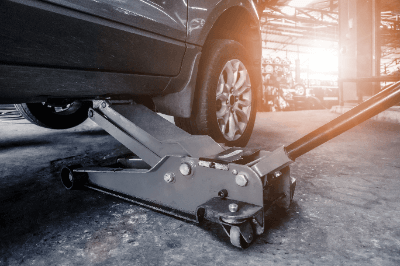What Is a Floor Jack?

A floor jack is a device that can lift heavy objects vertically with little force by using hydraulic or other power.
Floor jacks are mainly used to lift vehicle bodies, such as for car maintenance. There are several types of jacks used for car maintenance, and the two main types are pantograph jacks and floor jacks.
Pantograph jacks are screw-type and can lift heavy objects by manually turning a screw. They can also be folded, leading to space savings. While relatively easy to handle, they require a bit of force to raise and lower the jack.
Floor jacks use hydraulic pressure to lift heavy objects, making it easier to raise and lower with the jack and requiring less force.
Uses of Floor Jacks
Floor jacks are primarily used to raise and lower vehicle bodies in order to perform vehicle maintenance. Work performed by lifting the vehicle body includes changing tires and various oil changes.
Since cars are heavy objects, when using a jack to lift a car body, sufficient safety precautions must be taken. Also, since the position where the jack can be used (jack-up point) differs depending on the car model, it is important to check the maintenance manual that comes with the car thoroughly before using the jack.
A manual pantograph jack is pre-installed in the car as an on-board repair tool. A manual pantograph jack has a simple structure in which the pantograph moves up and down in accordance with the rotation of a screw, and its advantage is that it is small and takes up little space.
However, due to the small size of the jack itself, it takes a considerable amount of time to raise and lower the car body before it can be worked on, as it requires a lot of screw turning. Floor jacks are used for tasks such as changing tires so that the work can be completed quickly.
Principle of Floor Jacks
In principle, pantograph jacks are screw-type jacks, while floor jacks are primarily hydraulic.
1. Pantograph Jack
Pantograph jacks have a structure in which the pantograph moves up and down in accordance with the rotation of a screw. Since force is generated by the engagement of the screws, they are highly reliable and inexpensive due to their simple structure.
2. Floor Jack
Floor jacks are hydraulically operated and have an oil-filled tank inside. By raising and lowering the jack lever, pressure is applied to the oil in the tank, causing the oil to move toward the pump. As the oil moves toward the pump, the “ram” placed under the object to be lifted rises, allowing the heavy object to be lifted indirectly.
This action is based on Pascal’s principle of “when pressure is applied to a fluid” in a closed container, that pressure is transmitted equally to all parts of the fluid. Because hydraulic pressure can convert small amounts of energy into large amounts of energy, it is used in many situations in addition to jacks.
Hydraulic pressure is resistant to temperature changes in the surrounding environment, and it is easy to obtain high pressure, but its disadvantage is that if an oil leak occurs, the pressure is released. Therefore, if the container loses its airtightness due to age-related deterioration, etc., pressure can suddenly be released, which is dangerous, so hydraulic products should be inspected in advance for oil leaks before being used.
Compared to pantograph jacks, the equipment is a little larger because it uses the force of moving oil. The jack itself is also heavy, making it inconvenient to carry.
Types of Floor Jacks
1. General Floor Jack
Also known as garage jacks, these are general jacks that are raised and lowered mainly by hydraulic pressure. Depending on the product, they are mainly capable of lifting 1.5 to 2 tons.
In addition to hydraulic jacks, air jacks also exist, which use air power instead of oil to lift heavy objects. While these jacks can lift heavier objects more safely than floor jacks, they are the most bulky and can be used in a limited number of locations.
2. Low Floor Jack
This is a floor jack that can be lifted from a lower position. Depending on the shape of the vehicle and the height of the vehicle, it may be necessary to use this type.
The hydraulic system by which the jack is raised and lowered remains the same, but the height when lifted to the maximum is lower, so it is important to use this type of jack according to the uses of the vehicle.
Other Information on Floor Jacks
Pantograph Jack
Also known as a scissor jack, this jack has the same shape as the pantograph on the ceiling of a train. It takes time to raise the jack to the maximum because it is structured to move up and down by interlocking screws.
The greatest feature of pantograph jacks is that they are space-saving and inexpensive. Some products use hydraulic pressure instead of screws and can be easily raised and lowered.